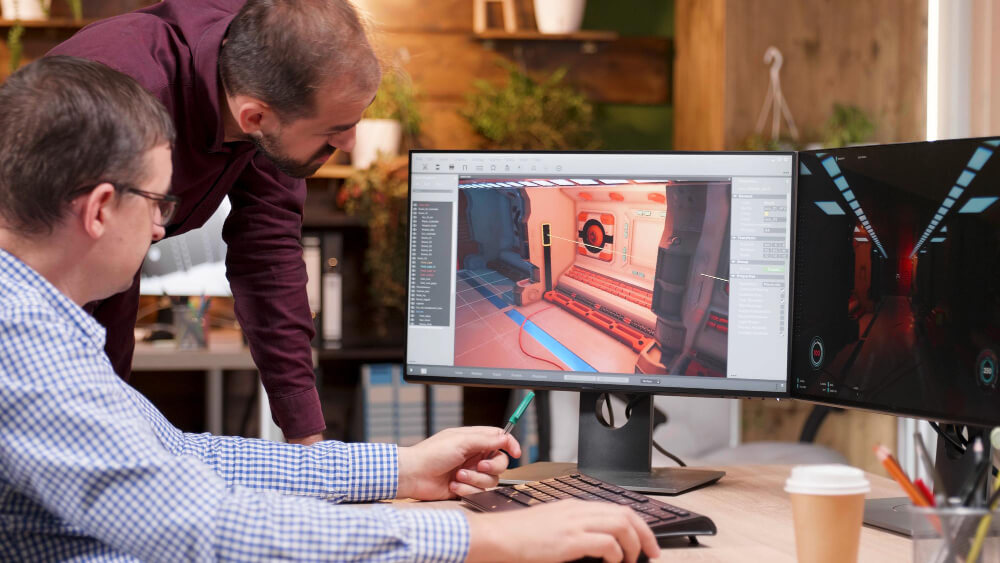- Call: +91 9999051533

Animation conveys a sensation of motion and change by quickly displaying a collection of static images that hardly differ from one another. It is used to bring characters, objects, and scenes to life in a range of mediums such as video games, television, films, video games, and web content. Animators use various techniques to create animation, including hand-drawn, stop-motion, computer-generated, and 3D animation. It can be used for entertainment, education, advertising, and many other purposes.
VFX, or visual effects, is the process of creating or manipulating imagery using a combination of digital and/or practical tools and techniques enhancing or create visual elements that cannot be captured during live-action filming. It is used to make or enhance a wide range of elements, including special effects, environments, creatures, and characters.
It can be categorized into two types: 2D and 3D. 2D VFX involves compositing different elements, such as green-screen footage, matte paintings, and computer-generated imagery (CGI), into a final shot. 3D VFX involves creating and animating objects, characters, and environments in a three-dimensional space.
It is commonly used in the film, television, and gaming industries, but it can also be used for other applications such as advertising, architecture, and education. It allows filmmakers and content creators to bring their visions to life and create a more immersive and visually stunning experience for the audience.
Let us understand each and everything in detail by the Best Graphic Designing Training Institute in Delhi–
The future of animation and VFX looks bright, with continued advancements in technology and growing demand for high-quality content across various mediums. The future of animation and VFX is exciting, with new technologies and trends shaping the industry and enabling creative to push the boundaries of what is possible.
Here are some possible trends and developments to look out for:
Augmented and virtual reality: With the rise of AR and VR technology, there will be increased demand for immersive experiences that blend the virtual and physical worlds.
Real-time animation: Real-time animation technologies such as game engines are becoming more sophisticated, enabling animators to create high-quality content in a shorter amount of time.
AI and machine learning: As AI and machine learning technology advances, it can be used to streamline and automate certain aspects of the animation and VFX process, such as rendering and compositing.
Cloud-based workflows: Cloud-based workflows can allow for easier collaboration and access to resources, making it easier for studios and individuals to work remotely.
Increased demand for streaming content: The rise of streaming services has increased demand for high-quality, original content across various genres and mediums.
A career in animation and VFX can be rewarding for those with a passion for creativity, storytelling, and technology. Here are some potential career paths in the field:
Animator: Animators create and bring characters and objects to life through movement and expression. They may work in 2D or 3D animation, using hand-drawn or computer-generated techniques.
VFX artist: VFX artists create and enhance visual effects for film, television, and other media. They may specialize in areas such as compositing, 3D modelling, or particle effects.
Concept artist: Concept artists create the initial designs and visualizations for characters, environments, and props in film, television, and gaming.
Motion graphics designer: Motion graphics designers create animated graphics and visual elements for a variety of mediums, including film, television, advertising, and web content.
Game designer: Game designers create and develop video games, using a combination of programming, design, and artistic skills.
Storyboard artist: Storyboard artists create visual representations of a script or story, helping to plan and visualize the structure of a film or animation.
To pursue a career in animation and VFX, one typically needs to have a strong portfolio of work, as well as a solid understanding of the relevant software and technology. Many schools offer degree programs or certificate programs in animation and VFX, and there are also many online resources and tutorials available for self-learning. Networking and building relationships with other professionals in the field can also be helpful for finding job opportunities and advancing in one’s career.
A career in animation and VFX can be both financially rewarding and creatively fulfilling, offering a variety of job opportunities and the ability to work on exciting and innovative projects, added by the best Full Stack Development Institute in Delhi.
There are many benefits to pursuing a career in animation and VFX, including:
Creativity: Animation and VFX allow for a great deal of creativity, enabling individuals to bring their imaginations to life through storytelling and visual design.
High demand: With the rise of streaming services and other forms of digital media, there is a growing demand for high-quality animation and VFX in film, television, gaming, and advertising.
Job opportunities: The animation and VFX industry is a global industry, providing job opportunities in many different regions and countries around the world.
Job security: Once established in the industry, animators and VFX artists can enjoy job security and stability, as demand for their skills and expertise continues to grow.
Flexibility: Many animation and VFX jobs can be done remotely or on a freelance basis, providing flexibility and the ability to work from anywhere.
Competitive salaries: According to the Bureau of Labour Statistics, the median annual wage for multimedia artists and animators in the United States was $77,700 as of Dec 2022.
Constantly evolving industry: With new technologies and techniques being developed all the time, the animation and VFX industry is always evolving, providing opportunities for continued learning and growth.